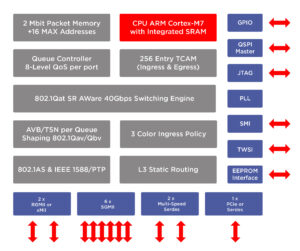 Marvell announced a family of high-port count, ultra-low latency automotive switches with multi-gigabit routing throughput capabilities. This innovative portfolio includes the industry’s first high-port count aggregation switch, offering all ports at gigabit capacity enabling clustering of safety-critical sensor data in an Advanced Driver Assistance System (ADAS) and data transfer over highspeed PCIe host uplink. Marvell’s latest automotive offering also includes a differentiated switch with integrated 100BASE-T1 PHYs and cutting-edge routing and security features that can be utilized in large gateway applications to connect multiple domain controllers.
Marvell announced a family of high-port count, ultra-low latency automotive switches with multi-gigabit routing throughput capabilities. This innovative portfolio includes the industry’s first high-port count aggregation switch, offering all ports at gigabit capacity enabling clustering of safety-critical sensor data in an Advanced Driver Assistance System (ADAS) and data transfer over highspeed PCIe host uplink. Marvell’s latest automotive offering also includes a differentiated switch with integrated 100BASE-T1 PHYs and cutting-edge routing and security features that can be utilized in large gateway applications to connect multiple domain controllers.
With increasing demand for advanced safety in autonomous drive vehicles and enormous data bandwidth in connected cars, Ethernet is enabling and proliferating within modern in-vehicle networks, previously dominated by low-speed legacy connections. These increasing market demands are addressed by Marvell’s 88Q5072 and 88Q6113 switches with a single chip, monolithic die solution resulting in a lower BOM cost and a reduced footprint.
Marvell’s automotive switches, based on the Arm Cortex-M7 architecture, can implement advanced protocols and security software on switch, offloading the external host processor. The devices equip time-sensitive networks in vehicles with added TSN features to enable low policing and filtering (IEEE 802.1Qci), and frame presumption (IEEE 802.1Qbu). The integrated L3 hardware accelerator allows multi-gigabit routing throughput up to 10Gbps without internal processor intervention. While facilitating large data transfers in-vehicle networks, the devices offer efficient sleep/wake capabilities supporting TC10 standard (OPEN alliance) lowering the overall power consumption. These highly secure multi-gig Ethernet switches have been purpose-built to address the increasing risk cybercrime represents to the automotive industry. The new solutions are designed with a robust level of security features including enhanced deep packet inspection (DPI) engine and trusted boot functionality at the foundational hardware layer.



Leave a Reply